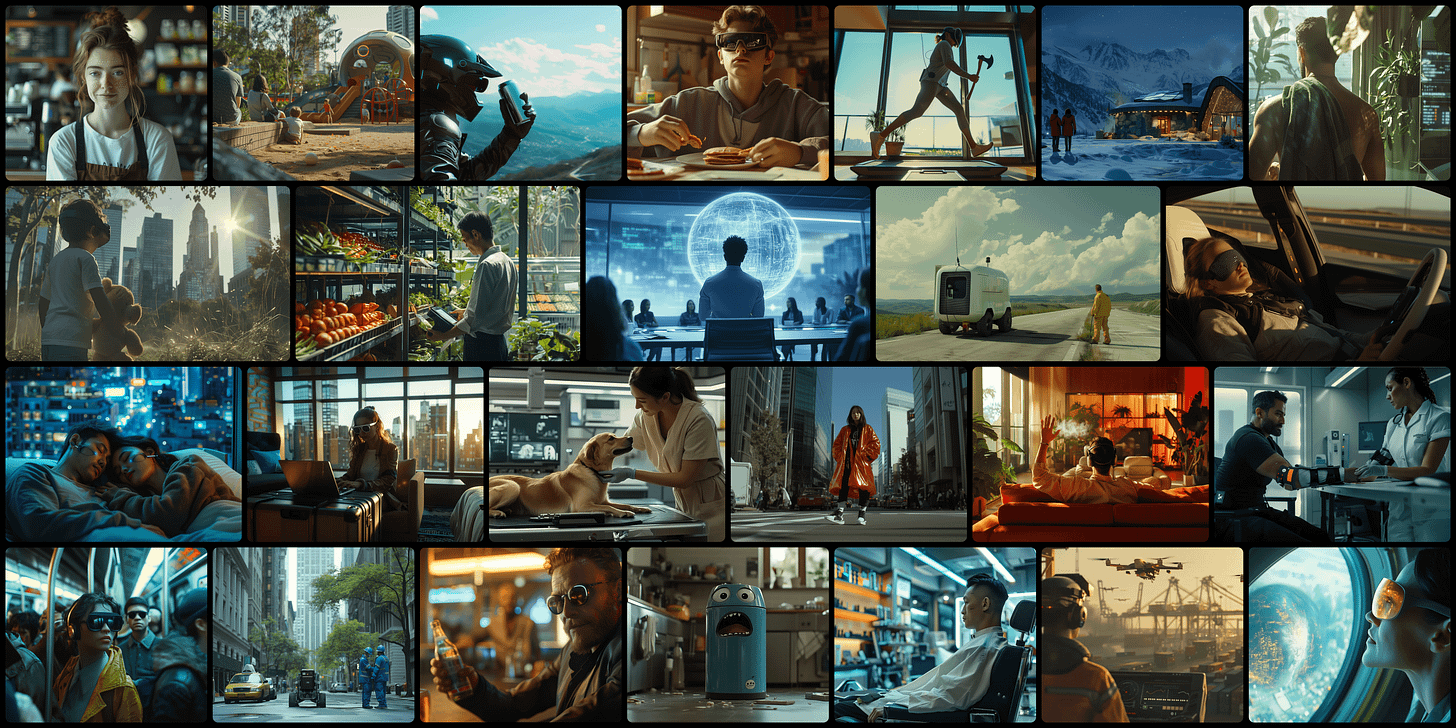After the third poke, she finally pulls off her headset and glares at him across the couch.
- Hmm?
- Have you seen those new humanoid household robots I sent you?
- Not yet. Why are you asking?
- I would love us to get one soon. It would be so cool to wake up and be served fresh pancakes by a personal robot chef.
She sighs, clearly unconvinced.
- Where will you keep our robot?
- You don’t like the idea of never doing the laundry again?
- Laundry? Folding your socks isn’t exactly the best reason to invest in cutting-edge robotics. There’s hardly any payoff.
He folds his arms and huffs in annoyance.
- You know I hate it.
- The economic value of doing the laundry is next to nothing. Think of it this way. Humanoid robots handling your laundry? Decades away. Humanoid robots handling hazardous materials? Just around the corner.
He flashes a cheeky grin.
- Some of my laundry could be classified as a hazardous material.
- Ugh… You’re gross. Stop it!
- You said that when I got back from that camping trip.
- Exactly, another one. Robots in remote areas? Absolutely. In cities crowded like ours? No way.
- Why not?
- We won’t have humanoid robots in homes without first fixing the housing costs in big cities. If you can barely afford an apartment fitting two adults, why would you sacrifice valuable space for a super-expensive home appliance? Please entertain my curiosity. Where will you keep our robot?
- Well… don’t we still have some space on the balcony?
She snorts, rolling her eyes in disbelief.
- Right. We’ll just park it on the balcony so it can freak out all the neighbours at night, like those creepy Halloween decorations.
- Every new piece of tech initially takes up a lot of space. This was true for computers and printers, and it’s true for robots. Robots are starting to look like us because the most efficient way to blend into the human world is to mirror human shape. I’m beginning to think that you just don’t like robots.
- I like everything. I’m just realistic. No, I’m not realistic. Actually, I’m more sceptically optimistic.
- About robots?
- Listen, warehousing, manufacturing, dangerous environments.
- Customer service.
- I classify customer service as a dangerous environment.
They giggle at the shared memory of working customer service jobs.
- Robots are popping up everywhere but we won’t see humanoid robots in every home until an entire generation is raised that feels comfortable living with them. We’re living in the prototype era of humanoid robotics.
- Okay, and what does your sceptical optimism have to say about robotic homemakers?
- It’s not just about the possibility or even efficiency. Efficiency is meaningless without effectiveness. It’s about actual results. Who cares how fast or long robots can work if there are more effective solutions?
- Like having a human doing your laundry?
She gives up with a long sigh.
- You really hate doing the laundry, don’t you? Let me free you from the burden of pushing a button.
- I can’t help it. I just don’t like doing it.
- Why waste money on a humanoid robot if you can solve your problem more efficiently?
- You want me to stop washing my clothes?
She leans back from the doorway, smirking.
- No, I want you to stop wearing them.
Their laughter drowns out the soft chime of the washing machine announcing that laundry waits for no one.
Hello Practical Futurists,
Welcome back from the future where technology takes space before it saves you time, and robots need their own bedrooms.
Hit the "Like" button at the top or bottom of this page to help other change-makers build a future-ready mindset.Great leaders practice experiencing the future, not just thinking about it.
Like athletes visualising their performance, they build vivid mental pictures of tomorrow to make better decisions today.
Our weekly workouts use futures thinking and practical sci-fi to help you create a library of future memories - turning abstract possibilities into reference points that can inform your choices.
To spark your imagination, here's a thought to start with:
Let's make this future personal.
We'll start by connecting this story to your life, transforming abstract possibilities into memories you can use to navigate tomorrow's challenges.
Personal life reflection prompts
1. Would you give up some of your living space to make room for a humanoid robot? If not, what could change your mind?2. Try to recall when you had to rearrange your entire living room to accommodate your first humanoid household robot: - What did you end up getting rid of to make space? - How did your daily routines change during the first week? - What unexpected improvement did this rearrangement result in?
3. How might your comfort level with home robotics differ from that of younger generations or your parents’ generation? What childhood experiences shaped these attitudes?4. Think about an enlightening conversation with your teenage cousin about living with household robots: - What perspective did they share that you hadn't considered earlier? - Which of your concerns did they dismiss as outdated? - What common ground did you discover despite the generational gap?
5. How do you handle disagreements about new technology with other household members? What works best?6. Think back to the first family conversation about which household tasks would be delegated to your first home robot: - What task was unanimously agreed upon as the first to automate? - Which family member had the most surprising request? - What unexpected compromise emerged from that discussion?
7. Would you prefer household robots that look and behave like humans, or would you rather have task-specific devices without anthropomorphic features? Why?Nice!
Your future memory library now has some valuable personal references. Let's fire up your thinking to add some professional leadership moments.
How will you help others navigate this future? It's time to create those memories.
Professional life reflection prompts
1. What 2 operational challenges would your industry face if humanoid robots were introduced into existing workflows? How would you address resistance from both customers and employees? 2. Think back to when you were presenting your organisation's "Phased Robotics Integration Plan" to the Board: - Which metric convinced the most sceptical Board Member? - Which aspect of your proposal received unexpected pushback? - Which pilot project was approved first and why?
3. How might architecture and urban planning evolve to accommodate robots in dense urban areas? What opportunities could this create for your industry?4. What 2 strategies could help your organisation navigate the "prototype era" of transformative technologies, e.g. robotics, without overcommitting resources or missing critical opportunities?5. Rather than full automation, how might human-robot collaborative models transform key processes in your organisation? What uniquely human capabilities would become more valuable?6. Recall your company's first "Human-Robot Collaboration Workshop": - Which department discovered the most surprising application? - What initial resistance transformed into enthusiasm by the end? - What unexpected policy had to be developed afterwards?
7. Where do you prioritise efficiency (doing things quickly) over effectiveness (achieving meaningful results) in your current operations? How could rebalancing these priorities improve outcomes?You did amazing! Excellent work!
Today's memories are added to your growing library of future experiences.
Thank you for expanding your imagination with us. Leaders with bold ideas move our world forward.
Think bright, and see you soon.
Pawel Halicki
Get your dose of Practical Futurism in your LinkedIn scroll
Connect with even more future-focused professionals.
Do you want stories like this in your inbox?
Join strategic imagination workouts that inspire change-makers in market-leading organisations, including Visa, Deloitte, Barclays, UEFA, Nielsen, Morgan Stanley, and many more.







